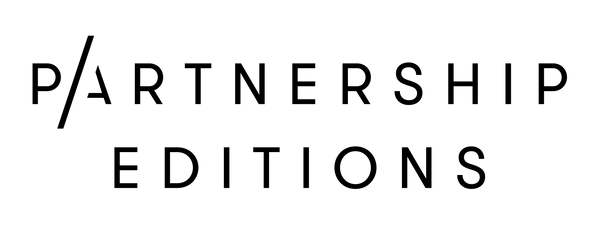
Author and Arts critic
96/ How I find creative inspiration in art by Chloë Ashby
This summer we’re excited to host a series of journals by author and arts critic, Chloë Ashby. Since graduating from the Courtauld Institute of Art, she has written for publications such as the Times, TLS, Guardian, FT Life & Arts, Spectator and frieze. Her debut novel, Wet Paint, was published in April 2022, and her second novel, Second Self, is out now.
For this first edition, Chloë talks about art as a source of inspiration for her writing, and runs us through the paintings that feature in her first two novels.
She also touches on the longstanding relationship between art and literature, and other writers who have used images as a hook or a window into another time and place, and gives us writing prompts based on her favourite Partnership Editions artworks.
 |
When I’m writing – or rather, not writing – I’ll stare at anything but a blank page. Sometimes all it takes to get my fingers tapping is a window, a readymade picture in a frame. There’s one to the right of my desk, overlooking our small patch of green and the row of terrace houses beyond. To my left are three wonky piles of books – overflow from the crowded shelves – and above them a pinboard of postcards scavenged from public galleries and museums. Straight ahead, arranged around my computer screen in a sort of halo, a handful of paintings and prints: oranges spilling out of a paper bag; two arms interlinked; and, my favourite, an artist at her easel.
 |
I might be searching for a starting point, a springboard for a story. Either that, or I’ll be partway through and in need of a pause. Art is one of the few things in life that can still my mind, the paint surface and pencil lines slowing my thoughts. Which is why I count myself lucky to call looking at art my job. I like to translate images into words. To take a work rendered in paint (or stone, performance, video) and unravel it on the page. To figure out how it makes me feel and what I like or dislike about it. To dip beneath the scumbled surface and uncover the social context.
It’s probably no surprise that an art critic would smuggle art into her fiction. I’m certainly not the first. Artists and writers have long been borrowing from one another, their work intertwining like ribbons. In the 19th century, the relationship deepened: art fired the imagination of French novelists Honoré de Balzac, Marcel Proust, Émile Zola. Entire novels have been born out of single artworks, while others have explored chapters of art history. In recent years, novelists have used art as a jump-start. Ali Smith was leafing through a magazine when she saw an allegorical fresco by the Italian painter Francesco del Cossa that would later lead to her unforgettable novel How to be both.
 |
My first novel, Wet Paint, began with an image, too. I first saw Édouard Manet’s A Bar at the Folies-Bergère in the flesh while I was studying at the Courtauld Institute of Art. The barmaid, Suzon, has been with me ever since, and she’s also a constant companion for my protagonist, Eve, who visits her once a week. Eve’s eyes snag on her pink cheeks, heavy eyes, pressed-together lips. She’s trying to work out how she’s feeling: sad, tired, stuck, the kind of lonely that can gnaw even in a crowd. When Eve becomes a barmaid herself, and a life model, the two women’s lives begin to blur.

In my new novel, Second Self, art plays a supporting role. When Cathy and Noah first got together neither saw children in their future. Eight years later, they’re happily married – and Cathy isn’t so sure. We follow her as she navigates her body and her marriage, and the way one threatens to cheat the other. At work in the conservation studios of the National Gallery, she chips away at the layers of overpaint on a canvas, hoping to find the clarity she craves. The book is about minds and bodies and paintings at the mercy of natural forces and social pressure.
Time for a pause, I think. I look to the pinboard of postcards on my left. The artworks change according to what I’m working on – my very own exhibition space – and there are still a few that were on my mind as I wrote Second Self. Odilon Redon’s pearly-pink seashell, because part of the book is set beside the sea. Bold and brash female nudes by Manet, Jenny Saville and Egon Schiele, because so much of it is about the experience of being in a woman’s body. Leonora Carrington’s The Giantess, cradling an egg, a symbol of new life, fertility. Paula Rego’s Love, full of feeling.

Art inspires me, always has, always will. I don’t know if it will continue to be a part of my fiction, but I do know it will always be a part of me. My life wouldn’t be the same without it, nor would my work. And, let’s face it, my study would look a little dull.
 |
FOLLOW CHLOË
@chloelashby
www.chloeashby.com
Order Second Self and Wet Paint
Chloë's Curation
-
All These Spaces VII (Framed)
![All These Spaces VII (Framed)]()
"Makes me think of cold and blustery winter days beside the sea."
- Vendor
- Harriet Hoult
- Regular price
- £450.00
- Sale price
- £450.00
- Unit price
- per
-
Yellow Floral Skirt (Framed) Sold
![Yellow Floral Skirt (Framed)]()
"I like that I can’t see her face. What’s she looking at? What has she heard?"
- Vendor
- Isabella Cotier
- Regular price
- Sold
- Sale price
- £420.00
- Unit price
- per


